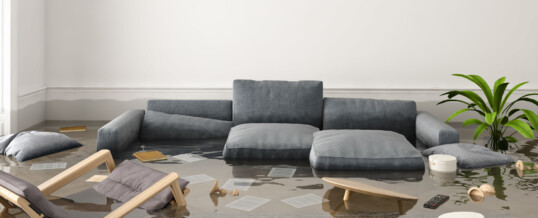
Due to their underground nature, basements are perpetually subject to mass amounts of water. Over time, this water can cause serious damage to a basement, leading to foundation cracks, mold growth, and general flooding.
This is why basement waterproofing exists. Need help understanding waterproofing? Then read on because we’re going to get into the detail below.
Why is Waterproofing Necessary?
First, you might be wondering why waterproofing is necessary in the first place. The answer can be summed up in two words: hydrostatic pressure.
This is the principle describing the force that gravity has on water. Namely, gravity forces water in a downward direction until it’s placing stress on a surface. Over time, this force can cause the surface to deteriorate, leading to cracks and other forms of degradation.
See, this is what occurs when groundwater seeps down toward a home’s foundation. It applies stress against the foundation, causing it to crack. Once cracks have formed, the groundwater seeps through them, entering the basement on the opposite side.
Because no one wants a wet basement, waterproofing becomes necessary. Sure, you could forego the use of waterproofing entities, but you would then be subject to problems such as flooding, mold growth, and musty smells.
What are the Different Types of Waterproofing?
There are many different ways to waterproof a home. Generally speaking, the more methods you utilize, the more your home will be protected. The primary forms of waterproofing include:
Sump Pump Installation
One of the most prominent forms of waterproofing is the sump pump installation. Sump pumps operate by gauging groundwater levels and pumping water away as needed. Ultimately, they prevent basements from flooding.
Sump pumps are positioned inside of sump pits. A sump pit is essentially just a hole in the ground. It’s typically dug in the corner of a basement and is used as a means of collecting groundwater.
Should the sump pit’s water levels ever reach an undesirable height, the sump pump will kick into gear, flushing some of the water out and ensuring that it doesn’t spill into the basement.
Of all basement waterproofing entities, the sump pump is arguably the most important. Not only does it prevent flooding, but it also reduces hydrostatic pressure around the house, reducing the risk of foundation cracks over time.
Drain Tile Installation
The sump pump is responsible for pumping out excess water around your home. But how does that water end up in the proper areas? With the use of drain tiles.
Drain tiles are positioned adjacent to the foundations of homes. In addition to redirecting pumped groundwater, they also catch groundwater and direct it to the sump pit. You can think of drain tiles as the circulatory system of a waterproofed basement.
Like the sump pump, drain tiles make a huge impact. They simultaneously reduce hydrostatic pressure and prevent flooding.
Foundation Crack Repair
Regardless of what you do to reduce the amount of water around your home, your foundation will incur cracks. Yes, you can greatly reduce the number of cracks, but you can’t eliminate them entirely.
For this reason, foundation crack repair is one of the keys to basement waterproofing. By repairing your foundation in a timely manner, you ensure that water isn’t seeping through to your basement. As a result, you reduce the risk of flooding, musty smells, and mold growth.
Waterproofing Membrane Installation
If you wish, you can add an extra layer of protection to your basement wall via a waterproofing membrane. This is a synthetic liquid material that hardens after it’s been applied and which can stop the flow of water for a decade straight. It reduces the need for foundation crack repair and also offers insulation to a basement.
You can make do without a waterproofing membrane. Plenty of basements do. But if you want to create the most habitable basement imaginable, you’re advised to install one.
Additional Waterproofing Methods
The methods reviewed above are the most popular forms of waterproofing. There are some others you can utilize, however.
One way to help waterproof a basement is to have the corresponding yard graded. This way, there will be no slopes leading toward the home’s foundation. If there are slopes leading to the foundation, they could cause groundwater to flow to the foundation more rapidly, resulting in even greater hydrostatic pressure.
Another method is to install downspout extensions. These entities fit onto the ends of downspouts, ensuring that they empty 5 or 6 feet away from the foundation as opposed to 1 or 2 feet. Again, they help keep hydrostatic pressure to a minimum.
You could also install a dehumidifier. Dehumidifiers will not only help to suck moisture out of the air, but they will also help to remove it from walls and floors. They can be vital in optimizing a basement’s atmosphere.
Should You Waterproof Your Basement?
We’ve discussed the modes of basement waterproofing. Now, you might be wondering: should you waterproof your basement? In most circumstances, the answer is yes.
Sure, you can get by without waterproofing your basement. You can use the area for the storage of miscellaneous items that you’ll never see again. But, just know, if the basement isn’t waterproofed, those items will be left vulnerable.
The only way to ensure that your basement doesn’t become subject to flooding, mold growth, and other harmful effects is to have it waterproofed. Waterproofing a basement turns it into a habitable space, one that can be lived in and enjoyed.
Understanding Waterproofing is Only Half of the Equation
Understanding waterproofing is important. But if you’re not implementing waterproofing entities, you’re not really making any difference. So, if you really want to keep your basement dry, you have to set things into motion.
Need help doing so? If so, and if you’re in the Baltimore area, we here at Armored Basement Waterproofing are the people to see.
Contact us now to discuss your waterproofing needs!
ShareNOV
